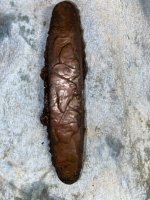ShipwreckHunter
Jr. Member
- May 15, 2015
- 38
- 137
- Detector(s) used
-
Garrett Master Hunter
GTI 2500
Infinium LS
Sea Hunter II
Pro-Pointer AT
- Primary Interest:
- Shipwrecks
The ship was called the Flor de la Mar: Flower of the Sea.
Built in 1502, weighing 400 tons, and made for traveling from Portugal to India and back, it was twice the size of other ships that had gone on the run.This type of vessel was called a ‘carraca’ or ‘nao’ by the Spanish, ‘caraque’ or ‘nef’ in French, and ‘carrack’ in English. In the Flor’s homeland of Portugal, the ship was known as a “nau”.
The Flor was part of an era of exploration, colonization, and exploitation. Three masts and six sails, square-rigged on the foremast and mainmast and lateen-rigged on the mizzenmast, drove the tall, rounded hull through thousands of miles of ocean waters. Ships of this type opened the riches of distant countries far away to European conquerors. Famous relatives to the Flor de la Mar include Columbus’ Santa Maria, Vasco de Gama’s São Gabriel, and Magellan’s Victoria.
Largest Naval Treasure Ever Lost
The Flor was something of a prototype for what would become the typical 16th Century India nau. The ship’s experience with difficulties maneuvering also led to the institutionalization of the “outer route.” Captains of heavily loaded big ships were ordered to sail east of Madagascar rather than navigating the fast Mozambique Channel. The Flor’s service life had been exceptionally long for a ship on the India run. Built for only three or four years of work, she lasted from 1502-1511. However, her design made her dangerously unseaworthy when fully loaded, and her service in various campaigns had necessitated many repairs.
Eventually, these issues would play a part in the Flor sailing into history with what some claim is the largest naval treasure ever lost.
Alfonso de Albuquerque
In command of the Flor was Alfonso de Albuquerque. He was known (depending on your perspective) as Alfonso The Great, The Terrible, The Portuguese Mars (Mars being the Roman God of War), The Caesar of the East, and The Lion of the Sea.
Alfonso was a Portuguese fidalgo, or nobleman, whose titles included Duke of Goa and Governor of Portuguese India.
His successes in conquest were many. Included in these, he had put the King of Cochin in power, built a fort in Cochin (now known as Kochi, in western India), and established the foundation for Portugal’s empire in the East. He had commanded a squadron of ships that sailed against the island of Ormuz in 1507: one of the chief centers of commerce in the East. He had brought Goa under Portuguese authority in 1510 and captured Malacca-one of the richest cities in the world at the time- in 1511. His successful strategy of trying to close all Indian Ocean naval passages imposed Portuguese power in a significant portion of Asia.
The Ship’s Treasure
It seems Alonso did not believe in the expression, “Don’t put all your eggs in one basket.” Most of his riches were placed in one ship: an enormous treasure filled the hold of the Flor de la Mar. As you might recall, the Flor’s design meant that it was dangerous and hard to maneuver when filled to capacity as well as having been repaired numerous times. Despite the ship’s unsafe condition, Albuquerque used it for its large capacity to transport his display of Malaccan treasures. There was also an impressive tribute from the Kingdom of Siam (Thailand) to the king of Portugal and all of Alfonso de Albuquerque’s own fortune. It was the largest treasure ever assembled by the Portuguese navy, and included 60 tons of gold from the house of the Sultan of Malacca. Supposedly, 200 gem chests were filled with diamonds, rubies and emeralds. Accompanied by four other ships, the Flor set sail for Portugal in November, 1511.
Empire’s Labor Lost
Perhaps in a stroke of irony, after taking Malacca’s riches, a violent storm blew up in the Straits of Malacca. The Flor de la Mar was shipwrecked on the reefs near the Straits, just northeast of Sumatra. The ship broke in two, and many were lost at sea. In addition, the treasure disappeared in the violent waves of the storm. Alonso, however, was saved. He jumped into a lifeboat with five of his officers. Following successes in other efforts, his detractors in the Portuguese court moved against him. They inspired King Manuel to replace Albuquerque with a personal enemy, Lopo Soares de Albergaria. Alonso de Albuquerque received news of this while at sea, and it was too much for him to bear. He died aboard ship on December 15, 1515.
The Treasure Hunt
As you might expect, treasure seekers have searched for this exceptionally rich prize ever since the first gem-filled chest got wet. One treasure hunter, Robert Marx, has reportedly spent somewhere around $20 million trying to find the Flor de la Mar. According to Marx’s statements, “…it’s the richest vessel ever lost at sea, with its hold loaded with 200 coffers of precious stones, diamonds from the small half-inch size to the size of a man’s fist.”
As far as we know, nobody’s found it yet.....
by Mark Dorr .. pictures by ShipwreckHunter ...
Mark Dorr grew up the son of a treasure hunter. His experiences led to working internationally in some surprising situations !!!
[/url]
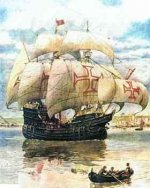
The Flor de la Mar or "Flower of the Sea" was built in 1502 and lost in 1511
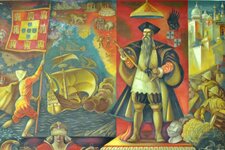
Alfonso de Albuquerque. He was known as Alfonso The Great, The Terrible, The Portuguese Mars (Mars being the Roman God of War), The Caesar of the East, and The Lion of the Sea.
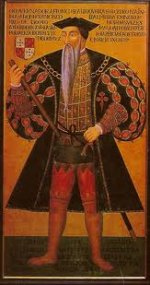
Alfonso de Albuquerque
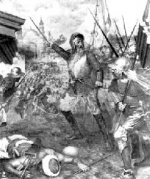
Alfonso and the conquest of Malacca.. In April 1511, Alfonso de Albuquerque set sail from Goa to Malacca with a force of some 1200 men and seventeen or eighteen ships. This was not an easy task, Sultan, Mahmud Shah was very rich and had a powerful army, many cannons, and even war elephants..The portuguese conquered the city on August 24th, 1511. After seizing the city Afonso de Albuquerque spared the Hindu, Chinese and Burmese inhabitants, but had the Muslim inhabitants massacred or sold into slavery.
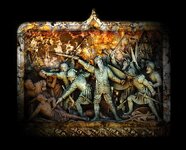
The conquest of Malacca ...
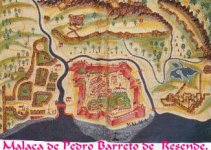
Early map of the fortress of Malacca ruled by Sultan, Mahmud Shah until the Portuguese conquest in 1511...
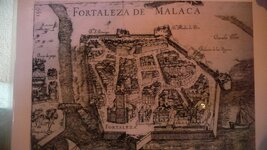
Early map of the fortress of Malacca ruled by Sultan, Mahmud Shah until the Portuguese conquest in 1511...
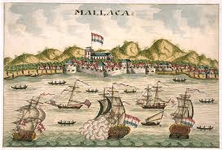
Painting of Malacca after the Portuguese conquest in 1511 ..
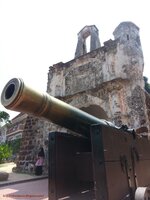
A Famosa ("The Famous" in Portuguese) is a Portuguese fortress located in Malacca, Malaysia. It is among the oldest surviving European architectural remains in south east Asia. The Porta de Santiago, a small gate house, is the only part of the fortress which still remains today.
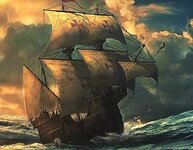
Flor de la Mar, which hit a reef during a violent storm in the strait of Malacca never to be seen again..
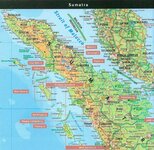
Somewhere in the Strait of Malacca lies the remains of the Flor de la Mar, one of the richest shipwrecks of all time....
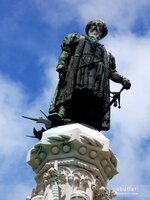
Albuquerque Monument on Afonso de Albuquerque Square in Lisbon, Portugal..
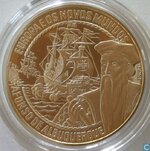
Portuguese coin commemorating Alfonso and the Flor de la Mar....
Built in 1502, weighing 400 tons, and made for traveling from Portugal to India and back, it was twice the size of other ships that had gone on the run.This type of vessel was called a ‘carraca’ or ‘nao’ by the Spanish, ‘caraque’ or ‘nef’ in French, and ‘carrack’ in English. In the Flor’s homeland of Portugal, the ship was known as a “nau”.
The Flor was part of an era of exploration, colonization, and exploitation. Three masts and six sails, square-rigged on the foremast and mainmast and lateen-rigged on the mizzenmast, drove the tall, rounded hull through thousands of miles of ocean waters. Ships of this type opened the riches of distant countries far away to European conquerors. Famous relatives to the Flor de la Mar include Columbus’ Santa Maria, Vasco de Gama’s São Gabriel, and Magellan’s Victoria.
Largest Naval Treasure Ever Lost
The Flor was something of a prototype for what would become the typical 16th Century India nau. The ship’s experience with difficulties maneuvering also led to the institutionalization of the “outer route.” Captains of heavily loaded big ships were ordered to sail east of Madagascar rather than navigating the fast Mozambique Channel. The Flor’s service life had been exceptionally long for a ship on the India run. Built for only three or four years of work, she lasted from 1502-1511. However, her design made her dangerously unseaworthy when fully loaded, and her service in various campaigns had necessitated many repairs.
Eventually, these issues would play a part in the Flor sailing into history with what some claim is the largest naval treasure ever lost.
Alfonso de Albuquerque
In command of the Flor was Alfonso de Albuquerque. He was known (depending on your perspective) as Alfonso The Great, The Terrible, The Portuguese Mars (Mars being the Roman God of War), The Caesar of the East, and The Lion of the Sea.
Alfonso was a Portuguese fidalgo, or nobleman, whose titles included Duke of Goa and Governor of Portuguese India.
His successes in conquest were many. Included in these, he had put the King of Cochin in power, built a fort in Cochin (now known as Kochi, in western India), and established the foundation for Portugal’s empire in the East. He had commanded a squadron of ships that sailed against the island of Ormuz in 1507: one of the chief centers of commerce in the East. He had brought Goa under Portuguese authority in 1510 and captured Malacca-one of the richest cities in the world at the time- in 1511. His successful strategy of trying to close all Indian Ocean naval passages imposed Portuguese power in a significant portion of Asia.
The Ship’s Treasure
It seems Alonso did not believe in the expression, “Don’t put all your eggs in one basket.” Most of his riches were placed in one ship: an enormous treasure filled the hold of the Flor de la Mar. As you might recall, the Flor’s design meant that it was dangerous and hard to maneuver when filled to capacity as well as having been repaired numerous times. Despite the ship’s unsafe condition, Albuquerque used it for its large capacity to transport his display of Malaccan treasures. There was also an impressive tribute from the Kingdom of Siam (Thailand) to the king of Portugal and all of Alfonso de Albuquerque’s own fortune. It was the largest treasure ever assembled by the Portuguese navy, and included 60 tons of gold from the house of the Sultan of Malacca. Supposedly, 200 gem chests were filled with diamonds, rubies and emeralds. Accompanied by four other ships, the Flor set sail for Portugal in November, 1511.
Empire’s Labor Lost
Perhaps in a stroke of irony, after taking Malacca’s riches, a violent storm blew up in the Straits of Malacca. The Flor de la Mar was shipwrecked on the reefs near the Straits, just northeast of Sumatra. The ship broke in two, and many were lost at sea. In addition, the treasure disappeared in the violent waves of the storm. Alonso, however, was saved. He jumped into a lifeboat with five of his officers. Following successes in other efforts, his detractors in the Portuguese court moved against him. They inspired King Manuel to replace Albuquerque with a personal enemy, Lopo Soares de Albergaria. Alonso de Albuquerque received news of this while at sea, and it was too much for him to bear. He died aboard ship on December 15, 1515.
The Treasure Hunt
As you might expect, treasure seekers have searched for this exceptionally rich prize ever since the first gem-filled chest got wet. One treasure hunter, Robert Marx, has reportedly spent somewhere around $20 million trying to find the Flor de la Mar. According to Marx’s statements, “…it’s the richest vessel ever lost at sea, with its hold loaded with 200 coffers of precious stones, diamonds from the small half-inch size to the size of a man’s fist.”
As far as we know, nobody’s found it yet.....
by Mark Dorr .. pictures by ShipwreckHunter ...
Mark Dorr grew up the son of a treasure hunter. His experiences led to working internationally in some surprising situations !!!
[/url]

The Flor de la Mar or "Flower of the Sea" was built in 1502 and lost in 1511

Alfonso de Albuquerque. He was known as Alfonso The Great, The Terrible, The Portuguese Mars (Mars being the Roman God of War), The Caesar of the East, and The Lion of the Sea.

Alfonso de Albuquerque

Alfonso and the conquest of Malacca.. In April 1511, Alfonso de Albuquerque set sail from Goa to Malacca with a force of some 1200 men and seventeen or eighteen ships. This was not an easy task, Sultan, Mahmud Shah was very rich and had a powerful army, many cannons, and even war elephants..The portuguese conquered the city on August 24th, 1511. After seizing the city Afonso de Albuquerque spared the Hindu, Chinese and Burmese inhabitants, but had the Muslim inhabitants massacred or sold into slavery.

The conquest of Malacca ...

Early map of the fortress of Malacca ruled by Sultan, Mahmud Shah until the Portuguese conquest in 1511...

Early map of the fortress of Malacca ruled by Sultan, Mahmud Shah until the Portuguese conquest in 1511...

Painting of Malacca after the Portuguese conquest in 1511 ..

A Famosa ("The Famous" in Portuguese) is a Portuguese fortress located in Malacca, Malaysia. It is among the oldest surviving European architectural remains in south east Asia. The Porta de Santiago, a small gate house, is the only part of the fortress which still remains today.

Flor de la Mar, which hit a reef during a violent storm in the strait of Malacca never to be seen again..

Somewhere in the Strait of Malacca lies the remains of the Flor de la Mar, one of the richest shipwrecks of all time....

Albuquerque Monument on Afonso de Albuquerque Square in Lisbon, Portugal..

Portuguese coin commemorating Alfonso and the Flor de la Mar....
Last edited by a moderator:



